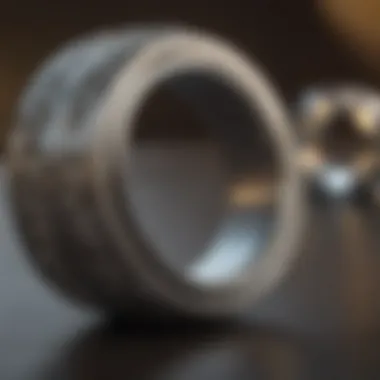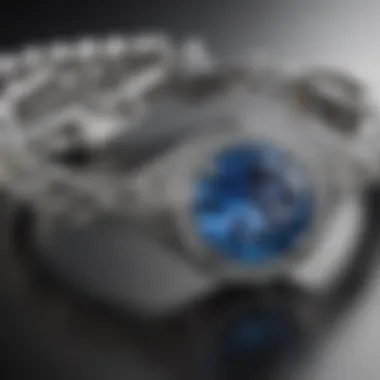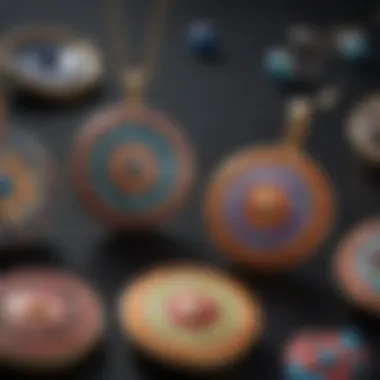Jewelry That Does Not Tarnish: Understanding Your Options


Intro
In recent years, the jewelry market has seen a notable shift. Consumers are increasingly aware of the importance of durability and maintenance in their choices. Particularly, tarnish-resistant jewelry continues to gain popularity. This shift is not merely a trend; it reflects a deeper understanding of how materials and craftsmanship affect the longevity of pieces. As a result, this article aims to highlight the options available for jewelry that does not tarnish, focusing on their materials, care needs, and advantages.
Gemstone Overview
Definition and Origins
Gemstones are naturally occurring minerals that are prized for their beauty, rarity, and durability. The term encompasses a wide range of materials, including both precious and semi-precious stones. Common examples include diamonds, rubies, sapphires, and emeralds. These materials have been admired since ancient times, utilized for both adornment and spiritual significance across cultures. Understanding the origins of different gemstones provides insight into their value and appeal.
Historical Significance
Throughout history, gemstones have held various meanings depending on the cultural context. For instance, the ancient Egyptians believed that turquoise offered protection. In contrast, the Romans associated garnets with love and loyalty. More recently, gemstones have become symbols of wealth and status. Their historical significance deepens their connection to human experience, making jewelry that incorporates them more than simple adornments.
Gemstone Properties
Hardness and Durability
The hardness of a gemstone affects its durability. Gemstones are rated according to the Mohs scale, which ranks minerals from 1 to 10 based on their ability to resist scratching. Diamonds, for example, rank at a 10, making them the hardest known substance. Understanding these properties is crucial for selecting pieces that hold up over time. For those interested in everyday wear, durability becomes a chief concern.
Color and Clarity
Color and clarity are paramount characteristics that influence the value of a gemstone. Color refers to the hue, tone, and saturation of a stone. Clarity, on the other hand, pertains to the presence of inclusions or blemishes. High-quality gemstones often exhibit exceptional color and clarity, making them sought after by collectors and enthusiasts. These properties not only enhance the aesthetic appeal of the jewelry but also contribute to its long-lasting beauty.
"The more you know about gemstones, the better equipped you are to make informed decisions in your jewelry purchases."
Understanding the nuances of gemstones prepares consumers for the broader conversation about tarnish-resistant jewelry options. As this article progresses, we will examine specific materials and modern techniques that enhance the longevity and appeal of jewelry.
Preamble to Tarnish-Free Jewelry
The importance of tarnish-free jewelry cannot be overstated in today's jewelry market. Consumers increasingly prefer pieces that maintain their shine and beauty over time. As taste evolves and lifestyle demands change, tarnish-resistant jewelry emerges as a valuable option for many enthusiasts and collectors.
Understanding this topic is crucial for several reasons. First, consumers are often unaware of the various materials that can be used to create jewelry that resists tarnishing. Traditional metals like silver are prone to tarnish due to environmental factors. Knowing that alternative materials exist allows buyers to make informed choices based on longevity and aesthetics.
Second, tarnish-free jewelry offers practical benefits. This type of jewelry often requires less maintenance. Regular polishing is typically necessary for traditional metals, which can lead to wear and reduced longevity. On the other hand, tarnish-resistant materials provide a solution, making them more appealing for everyday wear.
Lastly, the rise of innovative materials and technologies in the jewelry industry reflects broader trends toward practicality and sustainability. Many consumers today prioritize sustainability in all facets of their lives. Tarnish-free jewelry aligns with this trend by often incorporating eco-friendly materials and processes. This merges environmental responsibility with the consumer desire for high-quality, durable jewelry.
In summary, the exploration of tarnish-free jewelry options is essential for understanding modern practices in jewelry design and consumer preferences. By delving into the materials and technologies that enable this jewelry, we can appreciate its significance in the evolving landscape of the jewelry industry.
Understanding Tarnish
In discussing jewelry that resists tarnishing, it is crucial to grasp what tarnish actually is and how it affects various materials. Tarnish is a common concern for many jewelry owners, as it detracts from the visual appeal of their favorite pieces. Understanding tarnish allows consumers to make informed choices about the jewelry they buy and how to care for it. It is not just about aesthetics; tarnishing can also impact the longevity of items made from certain metals. Recognizing the chemical processes and key components involved in tarnishing is essential for anyone interested in maintaining their jewelry collection.
Chemical Process of Tarnishing
Tarnishing primarily arises from a chemical reaction that occurs when certain metals react with elements in their environment. For example, silver tarnishes due to its reaction with sulfur compounds found in the air or in substances that come in contact with it. This process results in the formation of silver sulfide, which appears as a dark coating that dulls the shine of the silver.
The rate at which tarnishing occurs can vary significantly based on environmental factors such as humidity, exposure to air, and the presence of specific chemicals. In essence, tarnishing is an oxidation reaction where the metal loses electrons, leading to degradation of the surface finish. Further, even metals like copper, which are often alloyed with other metals to create common jewelry, are prone to tarnishing when exposed to moisture or acidic substances.
Common Components of Jewelry That Tarnish


Several materials typically found in jewelry are susceptible to tarnishing. These include:
- Sterling Silver: Composed of 92.5% silver and 7.5% other metals, usually copper, sterling silver tarnishes easily due to its high copper content.
- Copper: Often used in costume jewelry, copper tarnishes and develops a green patina when exposed to air and moisture.
- Brass: A combination of copper and zinc, brass can discolor quickly due to oxidation.
- Aluminum and Bronze: These metals can also tarnish over time, particularly when subjected to humidity and pollutants.
To mitigate tarnishing, some jewelers apply protective coatings or develop alloys that resist tarnishing. Understanding these common components and their tarnishing tendencies can inform buyers about maintaining their jewelry effectively.
Materials That Resist Tarnish
The world of jewelry is vast, and consumers often seek pieces that not only shine but also maintain their luster over time. Understanding the materials that resist tarnish is essential for anyone interested in investing in jewelry that stands the test of time. Unlike traditional materials that may succumb to tarnishing, there are several options available that provide durability without sacrificing aesthetic appeal.
These materials are more than just choices; they represent advancements in technology, design, and consumer preferences. Identifying tarnish-resistant materials is crucial for jewelers and collectors alike, as this knowledge influences purchasing decisions, allowing for informed choices that align with lifestyle and expectations.
Sterling Silver with Protective Coatings
Sterling silver is a popular choice due to its appeal and affordability. However, it is susceptible to tarnish. Thankfully, advancements in protective coatings have improved its longevity. These coatings, such as rhodium or silver plating, serve as a barrier to oxidation. This not only enhances the shine but also reduces the need for frequent polishing.
Moreover, with proper care, jewelry made from coated sterling silver can remain dazzling for years. While the initial appeal may be compromised if the coating wears off, careful selection of quality pieces can lead to a satisfying balance of beauty and durability.
Gold and Its Alloys
Gold is inherently resistant to tarnish, but the real magic lies in its alloys. Pure gold, often referred to as 24-karat, does not tarnish. However, everyday wear indicates a need for increased strength. Thus, jewelers blend gold with metals like copper or silver to create various karat options. These alloys can help in achieving desirable hues like rose or white gold.
Each type of alloy has unique characteristics that influence tarnishing risk. White gold, for instance, is often coated in rhodium, adding to its tarnish resistance while providing a bright finish. Collectors often favor higher karats for their reduced tarnish potential, recognizing the importance of this factor in their jewelry decisions.
Platinum Jewelry
Platinum is often regarded as one of the most durable metals available in the market. Its natural resistance to tarnishing is a significant draw for consumers looking for timeless pieces. The density and strength of platinum allow it to withstand daily wear without the worry of losing its beauty.
Additionally, platinum develops a patina over time, which many consumers appreciate for its unique look. Unlike tarnish, this patina is an indicator of the metal's authenticity and character. Thus, for those seeking longevity in jewelry, platinum pieces often represent a sound choice.
Titanium and Stainless Steel
Titanium and stainless steel have gained traction in the jewelry industry for their resilience. Both offer exceptional resistance to tarnishing, making them suitable for daily wear. Titanium is lightweight yet incredibly strong, often used in contemporary designs and functional jewelry, such as wedding bands.
Stainless steel, on the other hand, combines iron, carbon, and chromium to create a corrosion-resistant material. This material is not only affordable but also adaptable to various designs and finishes. Both materials have become prominent options in the realm of modern jewelry.
Other Innovative Materials
In recent years, the jewelry market has seen the emergence of innovative materials that resist tarnishing. Metals like cobalt and ceramic composites are becoming more prevalent. Cobalt is known for its robustness and hypoallergenic properties, making it a suitable alternative for those with sensitive skin.
Ceramic composites, often used in modern or minimalist designs, provide a striking aesthetic while remaining tarnish-free. Their strength and comfort contribute to their rising popularity among consumers seeking both style and practicality. The versatility of these materials means that there are options to suit every taste.
By understanding these diverse materials and their unique properties, consumers can make informed choices that align with their personal style and practical needs. Each material brings forth distinct benefits, playing a critical role in the overall experience of owning tarnish-free jewelry.
The Role of Technology in Jewelry Manufacturing
The integration of technology in jewelry manufacturing represents a transformative stage in the industry. This evolution allows for the crafting of tarnish-resistant jewelry that combines aesthetics with durability. As consumers increasingly demand longevity in their pieces, technology plays a crucial role in meeting these expectations.
In this article, the focus will be on how advancements in manufacturing processes have enhanced the creation of tarnish-free jewelry. From innovative coatings to specialized alloys, technological developments are redefining what is possible in the world of jewelry.
Advanced Coating Techniques


Advanced coating techniques are pivotal in the jewelry industry, especially for pieces intended to resist tarnishing. These methods enhance the surface of the jewelry, providing a barrier against environmental factors that typically contribute to tarnishing.
Some popular coating techniques include:
- Electroplating: This process involves coating a metal with a thin layer of another metal, such as gold or rhodium. This not only adds aesthetic value but also creates a protective layer that helps prevent oxidation.
- PVD (Physical Vapor Deposition): PVD is a modern technique that deposits a thin film directly onto the jewelry surface. The resulting finish is hard, durable, and resistant to scratches, making it an excellent option for tarnish-resistance.
- Nano-coatings: These are extremely thin layers that can repel water and dirt. Such coatings help in minimizing tarnishing by creating a non-stick surface, thus reducing the interaction with harmful agents.
These techniques not only boost the longevity of the jewelry but also cater to diverse preferences in terms of finish and appearance.
New Alloys and Their Benefits
The development of new alloys has significantly impacted the jewelry market, especially in terms of tarnish resistance. Modern alloys are designed to enhance the properties of traditional metals while minimizing the drawbacks associated with tarnishing.
Some notable benefits of these new alloys include:
- Increased Strength: Innovations in alloy compositions have led to materials that are stronger and more resilient, which reduces wear and tear over time. For instance, white gold infused with palladium resists tarnishing better than traditional yellow gold.
- Corrosion Resistance: Certain newer alloys exhibit improved resistance against corrosion and tarnishing. For example, the use of nickel-free alloys has gained traction, appealing to both consumers and those with sensitivities.
- Aesthetic Versatility: Alloys can be engineered to achieve various colors and finishes, broadening design possibilities while maintaining durability. This flexibility allows for greater creativity in crafting unique, tarnish-resistant jewelry.
Comparing Tarnish-Resistant Jewelry Options
When selecting jewelry, the aspect of tarnishing often influences consumer choices significantly. Understanding how different tarnish-resistant options compare helps individuals make informed decisions. Factors like cost, aesthetic appeal, durability, and maintenance play vital roles. Each of these elements has implications for long-term satisfaction and value. In this section, we will explore these comparisons in detail, guiding readers toward optimal selection for their personal style and practical needs.
Cost Analysis
In the world of jewelry, the price point can vary widely based on materials and manufacturing processes. Tarnish-resistant jewelry is no exception. Some options, such as high-quality stainless steel, tend to be more affordable, while precious materials like platinum come with a higher investment. When evaluating costs, it is essential to consider:
- Initial Purchase Price: This is the upfront cost when acquiring the jewelry.
- Long-Term Value: More durable pieces may save money over time, requiring less frequent replacement.
- Potential Insurance Costs: High-value pieces may incur more significant insurance premiums.
"Evaluating cost involves more than just the price tag; it is crucial to consider the value over time."
Analyzing specific brands or materials can also reveal hidden costs, such as maintenance or cleaning necessary to uphold their hypoallergenic properties. Thus, balancing immediate expenses with longevity is central to a knowledgeable investment.
Aesthetic Differences
The aesthetic appeal of jewelry is often a crucial consideration for buyers. Different materials exhibit unique looks that can cater to varying styles and preferences. Popular tarnish-resistant options include:
- Gold and Its Alloys: Gold remains a timeless choice, often appearing in shades ranging from yellow to white. The finish can impact its look and feel.
- Platinum: Known for its dense and lustrous appearance, platinum offers a slightly gray tone that many find appealing. Its sheen adds a touch of elegance.
- Titanium: This material often presents a modern, industrial aesthetic that attracts a younger audience.
Consumers should consider how these styles fit with their existing collections or preferred fashion. Additionally, understanding how colors play with the hues of gemstones can enhance one’s overall jewelry repertoire. The aesthetic choices in tarnish-resistant jewelry are varied and can satisfy differing tastes.
Durability and Maintenance
Finally, how tarnish-resistant jewelry performs over time largely depends on its durability and maintenance requirements. This section examines:
- Material Strength: Each material has a different level of resilience to wear and tear. For instance, titanium is exceptionally strong, making it less susceptible to scratches than softer metals.
- Maintenance Needs: Regular cleaning to remove oils and dirt can ensure the longevity of the shine. Some materials may require specific cleaning agents to avoid damaging the finish.
Understanding the balance between durability and maintenance plays a key role in choosing tarnish-resistant jewelry. Opting for a higher-quality piece might initially seem costlier, but it could minimize ongoing maintenance efforts and extend the jewelry’s lifespan.
In summary, considering cost, aesthetic differences, and durability alongside maintenance is fundamental when comparing tarnish-resistant jewelry options. Educating oneself on these factors assists in achieving a satisfying purchase that complements individual lifestyles and expectations.
Caring for Tarnish-Free Jewelry
Caring for tarnish-free jewelry is crucial for maintaining its appeal and ensuring its longevity. While these pieces resist tarnishing better than traditional materials, they still require specific care to preserve their finish and appearance. Understanding how to properly care for your jewelry can prevent wear and keep it looking as new as possible.


Best Practices for Care
- Regular Cleaning: Even tarnish-resistant jewelry collects dirt and oils from skin contact. A gentle cleaning method involves using warm water and mild soap. Soak the piece for a few minutes, then use a soft cloth to gently wipe it clean. Avoid abrasive materials that can scratch surfaces.
- Avoid Harsh Chemicals: Substances like chlorine and bleach can damage tarnish-free coatings. Always remove jewelry before swimming in pools or using household cleaners. This prevents potential chemical reactions that could dull the shine.
- Limit Exposure to High Temperatures: Extreme temperatures can affect some protective coatings. Jewelry should be kept away from direct heat sources, such as stovetops or radiators, to maintain its integrity.
- Wear with Care: While these pieces are durable, they are not indestructible. Take off jewelry during sporting activities, gardening, or other strenuous tasks to prevent scratches or physical wear.
"Regular maintenance not only enhances the beauty of your pieces but also protects your investment."
Storage Recommendations
Proper storage is essential for preventing scratches or damage to tarnish-free jewelry. Here are some helpful storage tips:
- Individual Pouches: Store each piece in its own soft pouch to reduce friction with other items. This protects against scratches and keeps each piece isolated from potential tangles.
- Jewelry Boxes with Dividers: Use a jewelry box equipped with dividers. This keeps items organized and prevents them from coming into contact with each other, reducing the risk of damage.
- Avoid Humidity: High humidity can promote corrosion. Store items in a cool, dry place, and consider using silica gel packs in your storage area to absorb moisture.
- Regular Inspections: Periodically check your jewelry for signs of wear, like loose settings or scratched surfaces. Being proactive helps address issues before they become critical.
Consumer Trends in Tarnish-Resistant Jewelry
Contemporary consumers increasingly seek tarnish-resistant jewelry as a long-term investment. This interest is shaped by various factors including lifestyle changes, increased awareness of product durability, and the desire for unique aesthetic expressions. Understanding these trends helps in discerning market dynamics and consumer motivations.
Market Demand and Popularity
The demand for tarnish-resistant jewelry continues to grow significantly. Consumers gravitate towards materials that offer longevity and minimal maintenance. According to industry reports, this segment of the market has seen an uptick as more individuals prioritize value over time. Brands that promote tarnish-resistant options, such as Stainless Steel and Titanium, have gained traction due to their reputation for durability. Consumers appreciate that these materials maintain their visual appeal without the regular upkeep commonly associated with gold or silver jewelry.
- Key Factors Influencing Demand:
- Longevity of Products
- Minimal Care Requirements
- Value for Money
Apart from practicality, the unique selling propositions of these materials also resonate with buyers. It is no longer just about elegance; it is about finding pieces that stand the test of time and retain their luster. This trend is potent among millennials and Gen Z, who often seek jewelry that embodies both style and durability.
Influence of Social Media and Marketing
Social media plays a crucial role in shaping consumer preferences in the jewelry market. Platforms like Instagram and Pinterest have empowered brands to showcase their tarnish-resistant collections innovatively. High-quality images and engaging content highlight the advantages of such materials, driving interest and engagement among potential buyers. Influencers and jewelry designers using these platforms amplify the appeal of tarnish-resistant products.
- Key Marketing Strategies:
- Visual Storytelling
- Partnership with Influencers
- User-Generated Content
Effective marketing strategies often include user-generated content that encourages customers to share their own experiences with tarnish-free items. This peer validation fosters trust and motivates purchasing decisions. Additionally, educational content explaining the benefits of tarnish-resistant jewelry adds value to the consumer journey.
As consumers become more knowledgeable about jewelry materials and their properties, the demand for tarnish-resistant options is likely to climb.
Overall, consumer trends in tarnish-resistant jewelry highlight a shift towards smarter purchasing decisions amidst rising awareness of sustainability and product lifespan. These insights are essential for jewelry designers, retailers, and marketers looking to align their offerings with current consumer preferences.
The End: The Future of Tarnish-Free Jewelry
The interest in tarnish-free jewelry continues to grow, particularly as consumers become more aware of both the aesthetic and economic benefits. This section highlights key aspects concerning the future of tarnish-free jewelry, emphasizing advancements, consumer preferences, and sustainability considerations.
Predictions for Industry Changes
The jewelry industry is undergoing significant transformations. As technology advances, the creation of new, innovative alloys and coating substances is likely. This could enhance the range of tarnish-resistant options available to consumers. For instance, brands may start utilizing nano-coatings that effectively shield jewelry from all forms of oxidation and tarnishing. As researchers continue to explore materials like ceramics and synthetic gems, it is possible that a wider array of tarnish-free options will emerge.
Additionally, market dynamics may shift due to consumer demand for more sustainable practices. Jewelers will need to adapt to these changes, focusing on eco-friendly materials and production methods to remain competitive.
Embracing Sustainable Practices
Sustainability is not just a trend; it's becoming a standard in consumer expectations. In the context of tarnish-free jewelry, embracing sustainable practices can manifest in various ways. Manufacturers might prioritize recycled metals or explore alternative sources for raw materials. For instance, using reclaimed materials reduces the environmental impact associated with mining and production.
Moreover, consumer awareness is driving brands to be transparent about sourcing and production processes. Brands that communicate their commitment to sustainability in their tarnish-free jewelry lines are likely to build stronger bonds with their customers.
"Consumer behavior is rapidly shifting towards sustainability. Brands that adapt will not only meet demands but could also lead the market."



